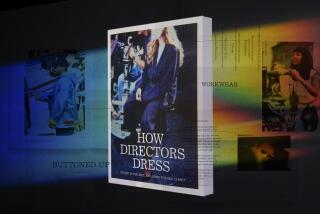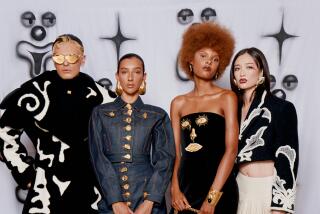Head of the Class
- Share via
As fashion spun into a maelstrom of ego, excess and experimentation, Bill Blass remained the standard-bearer for fine and elegant clothes that offered consistent style and quiet reassurance to generations of influential women.
Blass, who died at his Connecticut home of throat cancer Wednesday just 10 days short of his 80th birthday, helped shape the image of the American fashion industry through the 60 years he spent in New York. He established Bill Blass Ltd. in 1970.
“He was a statesman for the fashion industry,” said Helen O’Hagan, the former Saks Fifth Avenue executive who was his friend for 40 years. “He was a cult figure.” Personally and professionally, Blass, who was born in Fort Wayne, Ind., was the embodiment of restraint and simple Midwestern values.
His shows, particularly throughout the 1990s, became a respite from the whiplash-inducing trend machine. Blass could remake simple menswear pinstripes into a perfectly proportioned dress that would appeal to women from 25 to 75, or create a variety of shift dresses that women could wear for a decade.
“He understood how women dressed, and he listened,” said Craig Natiello, who was Blass’ head designer until he took the design post at Halston in 1999. “He would say, ‘That looks dreadful on you. Take it off!’ ”
Each season, Blass, who retired in 1999, took pains to understand his customers through 12 to 15 road trips to outlying cities, some as far-flung as Tokyo or as mundane as Milwaukee. In L.A., his clothes were sold at I. Magnin and Neiman Marcus. As his loyal customers gathered and gushed, Blass would assume his charming but gruff demeanor and delight in calling the most powerful women “dames,” “gals” and even “broads.” They loved it.
“He was one of the first great American gentlemen of fashion,” said John Fairchild, founder of trade journal Women’s Wear Daily. “He had the taste, the charm, the wit and the devilry, which made him a very interesting personality.”
Virtually every mention of the designer lists his unusual combination of skills, including, “a good eye for design, a shrewd business brain and a personality that charms the birds off the trees,” according to Linda Watson’s “Vogue: Twentieth Century Fashion” (Carlton Books, 1999).
Though he was undeniably one of the world’s best-known designers, a feat aided by his many licensing agreements, he aimed to stay out of the spotlight. “He was the most ‘unfashiony’ fashion designer,” Fairchild said. “He never talked about his own clothes.” Nor would he take credit for his many generous charitable acts, said Fern Mallis, director of 7th on Sixth, which produces the New York fashion shows.
Mallis recalled that on one occasion, during a Council of Fashion Designers of America meeting, Blass learned that a talented young designer, Christian Francis Roth, couldn’t afford the organization’s dues. “Bill thought that was ridiculous that he should be barred, since he had so much talent,” Mallis said. “The next day, the check came over from Bill to pay the membership dues.”
He also had to be cajoled into taking credit for the gift, and later, talked into accepting the CFDA’s Humanitarian award, Mallis said. Blass quietly paid to have fresh bouquets of flowers sent to the AIDS care unit at New York Presbyterian Hospital, Natiello recalled, and frequently wrote checks to designers and friends who had fallen on hard times. A devoted reader, he was famous for donating $10 million to the New York Public Library in 1994.
Practical and self-deprecating, Blass was never swayed by his own fame and accomplishments. “For years my clothes were considered very wearable, and I used to think that was a terrible insult,” Blass once said. “But there’s no point in making clothes nobody wears.”
New York designer James Purcell, who was twice considered to replace Blass after his retirement, was a young designer when he first met the fellow Hoosier. “I remember most his advice not to lose my Midwestern sensibility,” Purcell said. “That surprised me coming from such a sophisticated, urbane man.”
Yet by embracing good taste and restraint, Blass limited his impact on modern fashion. Though his lifelong publicist, Eleanor Lambert, called him “one of the loveliest men who ever lived,” she also offered an unvarnished appraisal of his work. “He was a fine designer,” she said, “but he never changed fashion. He made things in the spirit and mold of the time, but he did them his way.”
Still, he remained in high regard among colleagues and industry leaders. “Bill Blass’ designs were very sexy and trim,” said Vogue editor in chief Anna Wintour. “They had wonderful lines and were never vulgar. He was very clever at making ritzy-looking clothes out of simple fabrics, and simple-looking clothes out of rich ones.”
Blass was eventually replaced by Steven Slowick and Lars Nilsson after his retirement and aimed to stay in the background, though he assisted with two books about his career; a retrospective at Indiana University in Bloomington will debut in October.
Ever private, Blass requested no funeral or memorial.







